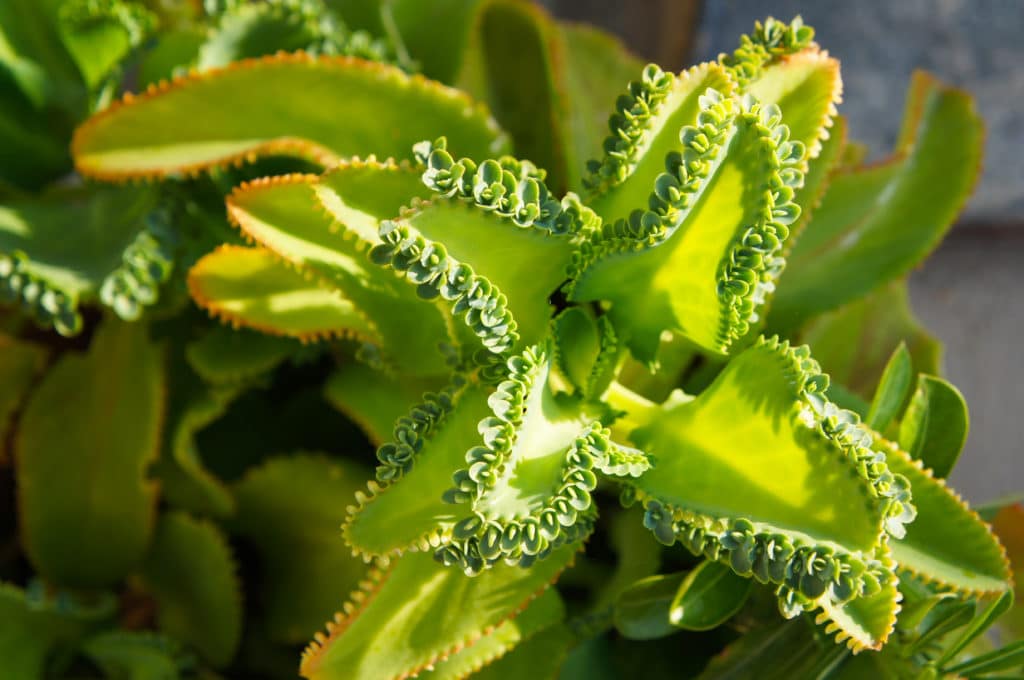
Have you ever seen a plant with tiny plantlets growing along the edges of its leaves? This unusual characteristic is what gives the Mother of Thousands plant its name. Native to Madagascar, this succulent grows up from one stem and can reach heights of 18 to 35-inches tall. The large blue-green leaves are pointed and narrow, growing up to 6-inches long and 3-inches wide.
Botanical Name: Kalanchoe daigremontiana
Common Name: Mother of thousands, devil’s backbone, alligator plant
Plant Type: Succulent
Mature Size: 3 ft. tall
Sun Exposure: Full sun, partial shade
Soil Type: Well-drained
Soil pH: Acid, neutral, alkaline
Bloom Time: Winter
Flower Color: Grayish-pink
Hardiness Zones: 9 to 11 (USDA)
Native Area: Africa
Toxicity: Toxic to humans, cats, and dogs
How To Care For Mother Of Thousands
The Mother of Thousands (bryophyllum daigremontianum) is a lovely and fascinating house plant, and it’s one of my favorites. If you have one of these plants in your home, you’ll want to learn how to care for it so that it lives long.
I’ll go through everything you need to know about caring for your Mother of Thousands in this article. But first, a brief rundown of mother of thousands plant care is in order.
How to grow Mother of Thousands: Mother of Thousands should be kept in a well-draining potting soil, watered seldom but thoroughly, and exposed to bright, indirect sunlight with low humidity at 65 to 75° F. The tiny plantlets that develop near the leaf margins will require some attention as they attempt to establish roots where they fall.
What is a Mother of Thousands?
The Mother of Thousands is a Crassulaceae species (related to the jade plant and Flaming Katy) that can be found throughout the Southwestern United States. It’s frequently mixed up with the chandelier plant (Kalanchoe delagoensis), which has similar growth habits and qualities. Kalanchoe daigremontiana, according to mother of thousands plant information, no longer produces seeds and may only reproduce via seedlings.
It’s simple to have a big harvest when you’re well-stocked in this. When these tiny baby plantlets fall, they may quickly spread and become overwhelming. While supplying a lot of plants for the propagator, those uninterested in increasing might find caring for the mother of thousands time-consuming. Don’t be concerned about removing the plantlets; more are certain to arrive as long as the healthy, still growing mother of thousands continues to grow.
The Diploid Kalanchoe Succulent Plant, Also Known as the Large-Leafed Succulent Plant, is drought tolerant and benefits from being watered on a regular basis. Because kalanchoe daigremontiana does not require frequent fertilization, it is similar to its relatives. If you want to feed your Kalanchoe plants while experimenting with how to grow them, once every few months should be sufficient.
Mother of Thousands Care
The Kalanchoe daigremontiana is a hardy, drought-tolerant succulent that can withstand high temperatures. It cannot grow in regions with more temperate or cooler climates. It’s typically cultivated as an easy houseplant.
Disclaimer
This plant is so easy to grow that it becomes invasive when cultivated outside. To minimize their dispersion, many gardeners keep them in pots.
Light
The majority of the thousands of mothers would rather have a bright area in your home that can be appreciated for several hours of light. However, excessive direct and intense afternoon sunshine might cause leaf scorch, so place them in shaded locations.
Your Mother of Thousands will flourish in an east-facing window. They prefer direct sunlight in the morning, when even in the summer months, the sun isn’t yet that hot. North-facing windows are frequently a poor choice for the Mother of Thousands – there won’t be enough hours of light for the plant if it’s turned toward this way, even during summer months.
You’ll know when your Mother of Thousands is receiving just the right amount of light – the leaves will be a brilliant green and have a lovely red outline.
Soil
Your Kalanchoe daigremontiana will require a well-drained potting medium, as it does with most succulents. Many growers use a cactus mix, while others prefer to combine sand or perlite into a basic potting soil. It’s great to utilize a clay vessel; it helps to retain moisture and removes it from the plant.
Water
The mother of thousands is drought-tolerant, but not as much as many succulent kinds. It will do better if it is hydrated on a regular basis, especially during the growth season. Even in spring and summer, it only requires water once every few weeks. It won’t be an issue if you forget now and again.
When the soil surface is still damp, water it again. nYou won’t overwater the roots if you gradually wet the earth. Reduce watering in the fall and winter. Limp leaves indicate that you’ve overwatered.
Temperature and Humidity
The ideal temperature for the mother of a thousand plants is usually around 65 to 75 degrees Fahrenheit. It should not be exposed to too much intense, direct sunlight. Before the temperatures drop below 40 degrees Fahrenheit, bring it back inside.
Fertilizer
Kalanchoe species, including the mother of thousands, can live without being fertilized on a regular basis.
Pruning
The plant doesn’t require any additional pruning beyond removing dead stalks and dropped plantlets.
Propagating Mother of Thousands
The plantlets it produces are far more readily developed from the taproot than are seeds. The main plant heads towards its winter dormancy period in the winter, and at that time, the plantlets are typically ready to remove. They’ll naturally fall off or can be easily removed from the leaf they’re connected with if they’re prepared to detach without applying a lot of force. Place the plantlets on a well-drained and damp potting soil where they will begin rooting.
Potting and Repotting Mother of Thousands
In many cases, the only thing you’ll need to do is repot a plant when it’s completely rootbound in its pot. These should be removed and disposed of or transplanted into another container with excellent drainage.
Overwintering
Bring your mother of thousands into the house for the winter. The plant can’t withstand temperatures below 40 degrees Fahrenheit. If you must move your plant indoors, keep it at least three feet away from a heater to avoid scorching its leaves or drying it out too quickly. Indirect heat may harm the leaves and cause the plant to dry out more rapidly than it can recover from.
